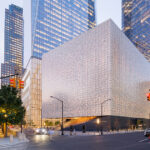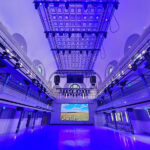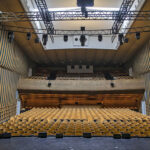
A Virtual Journey Under the Sea
Located in a multi-floor, 60,000-square foot facility in the former New York Times building on West 44th Street between 7th and 8th Avenues, National Geographic Encounter: Ocean Odyssey features various rooms that take guests on an incredible underwater adventure across the Pacific Ocean.
The journey starts in the Solomon Islands near Papua, New Guinea and heads northeast to the coast of California, traveling to a coral reef at night, down into the deep ocean, through a kelp forest and more. Combining interactive video technology with practical displays, it allows visitors to learn more about marine life, biodiversity and ocean conservation. I was guided on this experience by lead designer and project manager Charles Foster from design firm Lightswitch (who also happens to be an avid diver).

The Narrative Flow
 SPE Partners are the creators and producers for the whole project, who engaged a world-class global team of Academy, Grammy and Emmy Award-winning artists, including the design firm Falcon’s Creative Group and Pixomondo, the visual effects team behind Game of Thrones. “The story line of traveling from the Solomon Islands to the West Coast and what each scene, attractions and interactions might be along the journey was an interesting challenge,” says Foster. “There isn’t a central character who stays with you through your exploration, so the challenge was, how do you create little mini-stories that make sense in each scene, moving from one to the next? It was up to the entire creative team to conceive how this was going to work. ‘What are we going to do in this scene? What moves people through?’”
SPE Partners are the creators and producers for the whole project, who engaged a world-class global team of Academy, Grammy and Emmy Award-winning artists, including the design firm Falcon’s Creative Group and Pixomondo, the visual effects team behind Game of Thrones. “The story line of traveling from the Solomon Islands to the West Coast and what each scene, attractions and interactions might be along the journey was an interesting challenge,” says Foster. “There isn’t a central character who stays with you through your exploration, so the challenge was, how do you create little mini-stories that make sense in each scene, moving from one to the next? It was up to the entire creative team to conceive how this was going to work. ‘What are we going to do in this scene? What moves people through?’”

There were other narrative considerations that SPE Partners incorporated, including making the experience family-friendly. “Everyone’s holding their breath in the first scene when the tiger shark hunts the baby dolphin,” says Foster, “but that death would be too disturbing for some guests. You already get kids screaming in the bait ball scene which has a fun surprise for all of our guests — it gets a huge reaction.” The balancing act was finding solid content that engaged children but also offered enough science to intrigue parents and other adult visitors.

There were many conversations about how to define the narrative. “For example, with the Humboldt squid experience, we talked about how immersive it is,” recalls Foster. “You want to capture the impression, capture the emotion. How much do you show? How much do you hide? How much particulate is there in the water? Does it serve a narrative purpose of hiding the squid until they’re close? Just like anything, all of it is fact-based, but you want to tell a story. If you jumped off a boat off the coast of California or in the Sea of Cortez looking for Humboldt squid, would they show, or not show up? Here, they show up.”
Foster adds that the information in Encounter is scientifically accurate, and SPE worked with dozens of National Geographic scientists, researchers, explorers and photographers to ensure this. “There may be things in the audio track that don’t sound real or things that look like they are exaggerated, but they are not, they are verified and accurate,” he stresses.

The show starts off spectacularly with the first scene, an interactive underwater display utilizing eight projectors on the wall. The projections extend from the screen to the floor. The dome scene features 3D video in 8K resolution at 60 frames per second and with multi-channel surround sound.
Composer David Kahne gathered authentic ocean creature sounds from audio libraries around the world and developed an ambient soundtrack that adds an extra dimension to the presentation.
Following the bait ball scene is the Exploration Hall, where visitors can go even deeper on their adventure, hearing breathtaking stories from National Geographic photographers and deep-sea explorers, including Sylvia
Earle, Bob Ballard and Enric Sala, who, through transparent multi-media screens, share their inspiration and passion for the ocean.

Audiences can also enjoy a gaming challenge to clean up their own piece of the ocean or can play with holograms of the sea’s mightiest creatures. Everyone also will have the opportunity to take an individual pledge to take action that makes a difference in ocean conservation and share it with their social media communities.
Exploration Hall also features an art installation called “Message in a Bottle,” a series of painted plastic bottles, some of which include a recorded voice from a celebrity, oceanographer or scientist, by National Geographic Encounter explorer and artist Asher Jay.
“There are 265 bottles,” says Foster. “Each one is hand painted, and each one has a unique message placed inside and reflected on the outside.” Ecological conservancy is a theme of the bottle display and other art Jay has contributed to Encounter.

The Design Team
Led by principals Howard Werner and Norm Schwab, Lightswitch had two main roles on this project. The first was to collaborate with the rest of the creative team, to conceive a new experience: giving visitors an authentic under the sea experience, but with no live sea creatures and without getting wet. The second task was to realize the concepts and design ideas and get them implemented in a space that once housed printing presses.
A team of world-class professionals was assembled — the general contractor (Turner Construction), the lighting integrator (4Wall), the Austria-based AV design studio (Kraftwerk Living Technologies), the show designer (Falcon’s Creative Group), the CG video creator (Pixomondo) and Adirondack Scenic, all led by the SPE Partners team.
After several years of intensive creative design and development, SPE Partners took possession of the raw space in October 2016, and demolition began. 4Wall started installing fixtures and systems in April 2017, and programming began in August for two months. National Geographic Encounter: Ocean Odyssey opened on Oct. 6, 2017.
The attraction features a mixture of new technology and proven techniques. “All of the lighting fixtures that create the wave patterns are brand new, developed by Rosco with our feedback. They are a huge improvement on previous metal halide technology,” says Foster, who adds that all new fixtures on the job are LED — a requirement on a project where sustainability is key to the entire experience. On the flip side, the kelp maze, with small video displays, is comprised of scenic kelp and the notion of expansion through mirrors. “There is no older trick in the book than mirrors, but they’re super-effective.”
Well over 500 lighting fixtures were installed by 4Wall to light the space properly. Chauvet lighting fixtures provided the bulk of the fixtures that were spec’d for the
project.
The integration between disciplines in every scene was critical to the narrative success of each. The nighttime reef transforms from the dark and mysterious environment that a diver in the ocean might perceive into a glowing bioluminescent (and biofluorescent) landscape. The guest is now seeing the reef as a fish might see it, with different wavelengths of light causing the reef to glow. Scenic painters worked with the National Geographic Encounter’s science team to craft the look under both normal and ultra violet light. “This was one of the first scenes where we installed lighting,” Foster says. “It was important to give the scenic artists the correct lighting conditions so that they and the science team could make creative decisions.
“To balance the intensity found in the media content, we wanted some scenes to be playful,” continues Foster, “and when we’re able to focus on the real built environment, it’s nice to change up the pace.” Foster points to the kelp stairway as an example of a moment of respite. As guests continue their journey by descending a staircase, droplets of water appear to float upwards — an illusion created by lighting. “The concept here is that these are air bubbles floating up from the sea floor, and it’s a fun effect.”

An Automated Experience
At a Broadway show or a rock concert, an LD has a lighting console to program which a technician then runs during the event. But National Geographic Encounter requires no technician as the experience is entirely automated. “We still programmed the installation on a lighting console — a grandMA2 and an Mbox media server for pixel mapping — but then all of the control streams got uploaded to five Interactive Technologies CueServer 2 Pro devices that are triggered by Show Control and are totally automated,” says Foster. “Nobody has to think about the lighting in there at all. Periodically, there will be maintenance checks, but Encounter has been running for five months through three full intensive maintenance inspections. It has been completely solid. For a permanent installation, that’s super important, because we’ve learned through experience if you’re depending on maintenance, at some point failure will begin to negatively impact the visitor experience and the integrity of the design. We want every visitor to see the same show that the first guests saw on opening night.”
The result is a memorable, visually stimulating and thought-provoking journey that should excite even the most jaded adult or easily bored child. The average journey lasts at least one hour, but can easily last longer for more curious individuals. At its core, as Foster eloquently notes, National Geographic Encounter is not just about celebrating the natural beauty of marine life, but also exploring the role we all must play in keeping the oceans clean and healthy, for everyone to enjoy.
For more information, go to www.natgeoencounter.com


